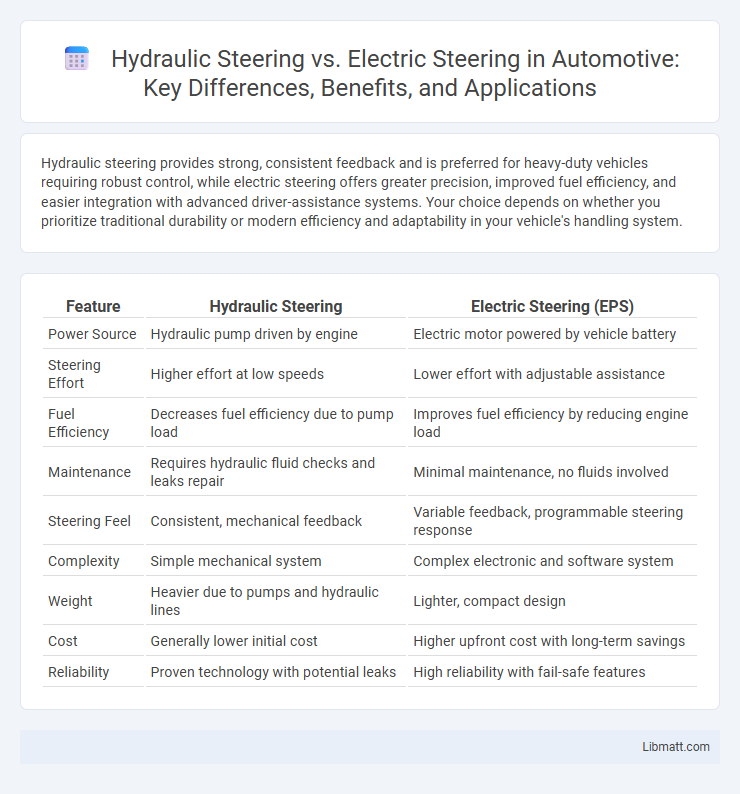Hydraulic steering provides strong, consistent feedback and is preferred for heavy-duty vehicles requiring robust control, while electric steering offers greater precision, improved fuel efficiency, and easier integration with advanced driver-assistance systems. Your choice depends on whether you prioritize traditional durability or modern efficiency and adaptability in your vehicle's handling system.
Table of Comparison
| Feature | Hydraulic Steering | Electric Steering (EPS) |
|---|---|---|
| Power Source | Hydraulic pump driven by engine | Electric motor powered by vehicle battery |
| Steering Effort | Higher effort at low speeds | Lower effort with adjustable assistance |
| Fuel Efficiency | Decreases fuel efficiency due to pump load | Improves fuel efficiency by reducing engine load |
| Maintenance | Requires hydraulic fluid checks and leaks repair | Minimal maintenance, no fluids involved |
| Steering Feel | Consistent, mechanical feedback | Variable feedback, programmable steering response |
| Complexity | Simple mechanical system | Complex electronic and software system |
| Weight | Heavier due to pumps and hydraulic lines | Lighter, compact design |
| Cost | Generally lower initial cost | Higher upfront cost with long-term savings |
| Reliability | Proven technology with potential leaks | High reliability with fail-safe features |
Introduction to Hydraulic and Electric Steering
Hydraulic steering systems use pressurized fluid to assist driver input, providing strong and consistent feedback suitable for heavy vehicles and off-road applications. Electric steering employs an electric motor and sensors to offer variable assistance, enhancing fuel efficiency and allowing integration with advanced driver-assistance systems. Both systems serve to reduce steering effort while optimizing vehicle control based on driving conditions.
How Hydraulic Steering Systems Work
Hydraulic steering systems operate by using fluid pressure generated by a pump, often driven by the engine, to assist in turning the vehicle's wheels. When the driver turns the steering wheel, a valve directs hydraulic fluid to one side of a piston within the steering gear, amplifying the steering force applied. This mechanism provides smooth, responsive control, especially in larger vehicles where greater steering effort is required.
How Electric Steering Systems Work
Electric steering systems use an electric motor to assist the driver in turning the wheels by interpreting signals from sensors that detect steering input and vehicle speed. The motor adjusts the amount of assistance provided, reducing driver effort and improving fuel efficiency compared to hydraulic systems. Your vehicle's onboard computer continuously processes sensor data to optimize steering response and enhance overall driving precision.
Key Differences Between Hydraulic and Electric Steering
Hydraulic steering systems use pressurized fluid to assist driver input, offering strong feedback and durability suitable for heavy vehicles, whereas electric steering relies on an electric motor and sensors, providing precise control and improved fuel efficiency. Hydraulic steering generally requires more maintenance due to fluid and pump components, while electric steering reduces mechanical complexity and enhances integration with advanced driver-assistance systems (ADAS). Electric steering systems also allow customizable steering effort and smoother operation, contrasting with the mechanical feel characteristic of hydraulic setups.
Advantages of Hydraulic Steering
Hydraulic steering systems provide superior tactile feedback and greater power assist at low speeds, making them ideal for heavy-duty applications and off-road vehicles. They are renowned for their durability and reliability under harsh operating conditions, offering consistent performance with minimal electronic dependency. Hydraulic systems also provide smoother handling and better control in demanding environments due to their robust mechanical design and high torque capacity.
Advantages of Electric Steering
Electric steering systems offer significant advantages in precision and efficiency compared to hydraulic steering, reducing energy consumption by eliminating the need for engine-driven pumps. Your vehicle benefits from enhanced responsiveness and easier customization through software, enabling adaptive steering feel and integration with advanced driver-assistance systems (ADAS). Maintenance demands are lower as electric steering avoids hydraulic fluid leaks and complex mechanical components, improving overall reliability.
Performance Comparison: Hydraulic vs Electric Steering
Hydraulic steering offers robust performance with strong feedback and durability, especially favored in heavy-duty and off-road vehicles for its reliability under high loads. Electric steering provides precise control and improved fuel efficiency by reducing engine load, enabling customizable steering feel and advanced driver-assistance systems. Your choice depends on performance needs: hydraulic excels in power and toughness, while electric delivers efficiency and adaptability.
Maintenance and Reliability Concerns
Hydraulic steering systems require regular maintenance, including fluid checks, hose inspections, and potential pump replacements due to leaks or wear, which can lead to higher long-term upkeep costs. Electric steering systems offer improved reliability with fewer moving parts, reducing maintenance needs and the risk of hydraulic fluid leaks. However, electric steering depends on electrical components and sensors that may require specialized diagnostics and repairs if they fail.
Cost Considerations for Steering Systems
Hydraulic steering systems generally incur higher maintenance costs due to the need for regular fluid checks, pump replacements, and potential leakage repairs, while electric steering systems offer lower upkeep expenses with fewer moving parts and no hydraulic fluid. Initial installation costs are typically higher for hydraulic systems because of the complexity of pumps and hoses, whereas electric power steering (EPS) systems tend to have a higher upfront electronic control unit cost but benefit from simpler integration with modern vehicle architectures. Over the vehicle's lifespan, electric steering provides cost savings through enhanced energy efficiency and reduced wear, making it a more economical choice in many automotive applications.
Choosing the Right Steering System for Your Needs
Hydraulic steering systems provide strong, consistent feedback and durability, making them ideal for heavy-duty vehicles and demanding off-road conditions. Electric steering systems offer precision, energy efficiency, and easier integration with advanced driver-assistance technologies, suitable for modern passenger cars and urban driving. Evaluating factors such as vehicle type, driving environment, maintenance preferences, and technological compatibility is essential in choosing the right steering system for your needs.
Hydraulic steering vs Electric steering Infographic

 libmatt.com
libmatt.com